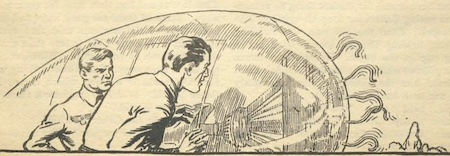Science Fiction
Dictionary
A B C D E F G H I J K L M N O P Q R S T U V W X Y Z
Latest By
Category:
Armor
Artificial
Intelligence
Biology
Clothing
Communication
Computers
Culture
Data Storage
Displays
Engineering
Entertainment
Food
Input Devices
Lifestyle
Living Space
Manufacturing
Material
Media
Medical
Miscellaneous
Robotics
Security
Space Tech
Spacecraft
Surveillance
Transportation
Travel
Vehicle
Virtual
Person
Warfare
Weapon
Work
"The idea I want to push next is that the United States should make Siberia a Protectorate. Pay the Russians off – a hundred, two hundred billion dollars – and simply run Siberia in an ecologically responsible way."
- Gregory Benford
| Radiant Power Receptor (DeKalbs) | ||
| A device which received and used energy transmitted from a station or satellite. |
This story appeared a long time ago; it's title survives as a nickname for a real invention (telefactoring devices - called "waldoes")which was first described in this story by the author. One of the most interesting subplots of the story involves what amounts to broadcast power, with cars and appliances no longer in need of engines or wired connections to power sources, respectively.
Heinlein didn't invent the idea of 'radiant power' (that is, wireless transmission of power), but he uses it to great effect in the story.
| He had seen radiant power grow up. He had seen the great transmission lines removed from the sky - mined for their copper. |
| Technovelgy from Waldo,
by Robert Heinlein. Published by Astounding Science Fiction in 1942 Additional resources -
|
By the end of the story, the DeKalb power receptors were 'bewitched' to pull power right out of thin air (Heinlein makes it work in the story - really!) The interesting thing to me about this idea is that scientists are actually working on a similar idea - pulling power out of an alternate universe. If you think that both Heinlein and these scientists are guilty of 'magical thinking', you're not alone. Here's how Heinlein describes it:
"Not witch doctor - hex doctor..."
The skycar looked quite ordinary. Stevens examined the deKalbs and saw some faint chalk marks on their metal sides... "Watch while I cut in reception."
Stevens waited, heard the faint hum as the circuits became activized and looked.
The antennae of the deKalbs, each a rigid pencil or metal, were bending, flexing, writhing like a cluster of worms. They were reaching out, like fingers.
Don't miss Heinlein's description of the broomstick speedster, a minimalist craft that could whisk two people from the Earth's surface to a space station in low Earth orbit using the magic of broadcast power.
The first person to actually make wireless transmission of power possible was Nikola Tesla. He built a laboratory in Colorado Springs, Colorado, to develop his idea. The largest Tesla Coil ever built (the 'Magnifying Transmitter') could generate up to 300,000 watts of power, and produce a bolt of lightning 130 feet long. Tesla actually managed to successfully transmit about 30 to 50 thousand watts of power without wires using the coil.
The part of the Heinlein story that fascinates me is the character who links increased obesity and sedentary natures in children with an increase in radiation in the environment. He wears a lead-lined suit and lives in a lead-lined house, and finds that he is healthier than his peers.
"What!" put in Stevens. "You don't mean to stand there and tell me an old witch doctor fixed your deKalbs."

(Broomstick speeder with Schneider-deKalbs)
Comment/Join this discussion ( 3 ) | RSS/XML | Blog This |
Additional
resources:
More Ideas
and Technology from Waldo
More Ideas
and Technology by Robert Heinlein
Tech news articles related to Waldo
Tech news articles related to works by Robert Heinlein
Radiant Power Receptor (DeKalbs)-related
news articles:
- Shape-Shifting Antennas
- Shape-Changing Metal Antenna
- Cellphone Harvests Power From Ambient Radio Signals And Light
| Roborock Saros Z70 Is A Robot Vacuum With An Arm |
| Secret Kill Switch Found In Yutong Buses |
| The Desert Ship Sailed In Imagination |
| The Zapata Air Scooter Would Be Great In A Science Fiction Story |
Want to Contribute an
Item?
It's easy:
Get the name of the item, a
quote, the book's name and the author's name, and Add
it here.
| <Previous | Next> |
|
|
|
Technovelgy (that's tech-novel-gee!) is devoted to the creative science inventions and ideas of sf authors. Look for the Invention Category that interests you, the Glossary, the Science Fiction Invention Timeline, or see what's New.
|
Science Fiction
Timeline
1600-1899
1900-1939
1940's 1950's
1960's 1970's
1980's 1990's
2000's 2010's
'Jason had been guiding the caravan of cars as usual...'
"The robot solemnly hit a ball against the wall, picked it up and teed it, hit it again, over and again...'
'There was a wall ahead... It was riddled with holes that were the mouths of tunnels.'
'...support the interior human structure against Jupiter’s pull.'
'Anything larger than a BB shot it picked up and placed in a tray...'
'The German chemists have discovered how to supply the needed elements in compact, undiluted form...'
'Compounds devised by the biochemists for the rapid building of bone...'
'The car faltered as the external command came to brake...'
'It is about the size and shape of a kitchen stool, gyro-stabilized...'
